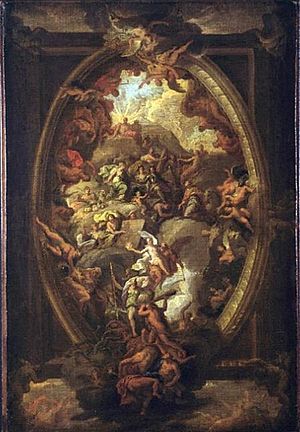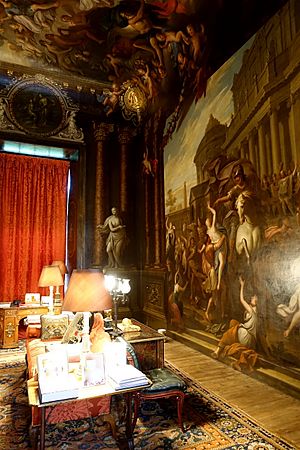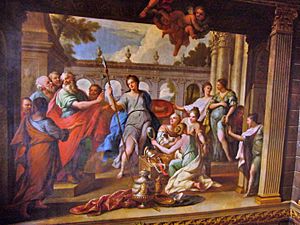James Thornhill facts for kids
Quick facts for kids
Sir James Thornhill
|
|
|---|---|
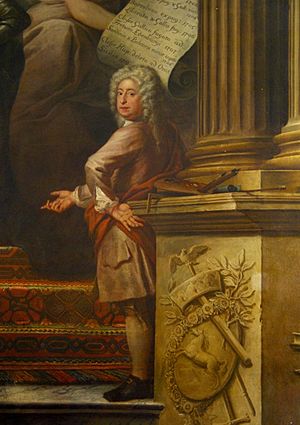
Self portrait, detail of a painting in the Painted Hall of the Greenwich Hospital, Greenwich, London
|
|
| Born | 25 July 1675 Melcombe Regis, Weymouth, England
|
| Died | 4 May 1734 (aged 58) |
| Nationality | English |
| Occupation | Architect |
| Children | Jane |
| Parent(s) | Walter Thornhill Mary Sydenham |
| Buildings | Moor Park |
Sir James Thornhill (born July 25, 1675 or 1676 – died May 4, 1734) was an English painter. He was famous for creating large paintings that showed historical events. He worked in a style called baroque, which was popular in Italy.
Thornhill painted huge murals, which are paintings directly on walls or ceilings. Some of his most famous works include the "Painted Hall" at the Royal Hospital in Greenwich. He also painted inside the dome of St Paul's Cathedral and at grand homes like Chatsworth House and Wimpole Hall.
Contents
Early Life and Training
James Thornhill was born in Melcombe Regis, a town in Dorset, England. His father was Walter Thornhill and his mother was Mary Sydenham.
In 1689, when he was about 14, James began training with Thomas Highmore. Highmore was an artist who specialized in decorative painting. James also learned a lot from two famous foreign painters, Antonio Verrio and Louis Laguerre. They were working in England at the time.
James finished his training in 1696. In 1704, he became a full member of the Painter-Stainers' Company in London. This was a group for painters and decorators.
Famous Paintings and Murals
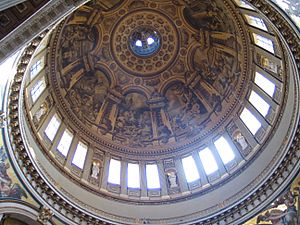
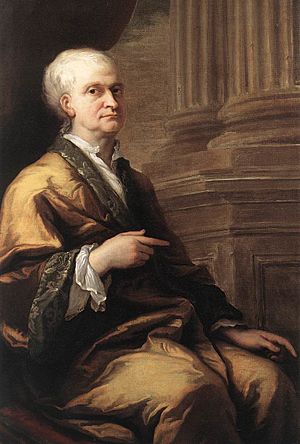
Thornhill became well-known for decorating the insides of palaces and large houses. His paintings often showed figures in grand, dramatic poses.
The Painted Hall
In 1707, he received an important job to decorate the Hall at the Old Royal Naval College. This hall is now famously known as the Painted Hall. He worked on it for many years, from 1707 to 1727.
The paintings in the hall tell a story using symbols and figures. They show the line of English monarchs, starting with William III and Mary II up to George I.
St Paul's Cathedral Dome
On June 28, 1715, Thornhill was chosen to paint the inside of the dome of St Paul's Cathedral. A committee decided to give him the job. The Archbishop of Canterbury, Thomas Tenison, wanted an English Protestant painter.
The eight scenes in the dome were painted between 1716 and 1719. They show important moments from the life of St. Paul. Thornhill used a special painting style called grisaille, which uses different shades of grey to look like sculptures.
Paintings in Grand Houses
Thornhill's large murals in big houses often connected to current events. He painted at Chatsworth House in 1707 and 1708. One famous painting there is the continuous wall and ceiling painting in the Sabine room.
At Hanbury Hall, he painted the ceiling of the main staircase. It shows Olympian Gods and the story of Achilles. He also included a small portrait of Rev Henry Sacheverell. This man was a political speaker who was put on trial. Thornhill showed him being sent to the Furies, who were spirits of punishment.
In 1716, Thornhill painted the ceiling of the Great Hall at Blenheim Palace. This painting celebrated the 1704 victory of John Churchill, 1st Duke of Marlborough, at the Battle of Blenheim. This battle was part of the War of the Spanish Succession.
His last big project was painting the chapel at Wimpole Hall. He started sketches in 1713 and finished the work by 1724. The paintings include fake architecture and statues that look real. The east wall above the altar shows the Adoration of the Magi.
In 1725, he offered to paint the ceiling of the New Council Chamber at the Guildhall in London for free. He was given a valuable gold cup for his work. Some of these paintings, like an Allegory of London, still exist today.
Other Artistic Contributions
In his home county of Dorset, Thornhill decorated the altar at St. Mary's Church in Weymouth. He painted a picture of the Last Supper there. Thornhill was also good at painting portraits of people.
He also painted the walls and ceiling around the grand staircase at Hanbury Hall in Worcestershire.
Art Schools
In 1711, Thornhill helped start an art academy with Sir Godfrey Kneller. An academy is a school for artists. Thornhill later became the head of this academy.
In 1724, he opened his own free drawing school at his home in Covent Garden. This school was very successful.
Family Life
The famous artist William Hogarth was a student at Thornhill's second art academy. On March 23, 1729, Hogarth married Thornhill's daughter, Jane.
Honors and Recognition
James Thornhill received many honors for his work. In June 1718, King George I made him the court painter. In March 1720, he became the Serjeant Painter, which was a very important position.
On May 2, 1720, the king made him a knight. This meant he was the first English artist to be given the title "Sir." In the same year, he was the head of the Painters' Company. In 1723, he became a member of the Royal Society, a group for important scientists and thinkers.
Political Career
Thornhill also entered politics. He was elected as a Member of Parliament for Melcombe Regis in 1722 and again in 1727. He usually voted with the government during his time in Parliament. He even gave a painting he made to the local church.
Homes and Designs
In 1718, Thornhill moved into a large house in Covent Garden. In 1725, he updated Thornhill House in Dorset. He designed it in the Palladian style, which was a popular architectural style.
In 1720, he also tried designing buildings. He helped design Moor Park with another architect, Giacomo Leoni. Thornhill also painted the ceiling of the entrance hall and other rooms in Moor Park.
Copying Raphael's Cartoons
Towards the end of his life, Thornhill didn't get as many big painting jobs. So, he started making copies of the famous Raphael Cartoons. These were large designs by the artist Raphael, kept at Hampton Court.
Thornhill made full-size copies, which he finished in 1731. He also made 162 smaller studies of faces, hands, and feet. He wanted to publish these for art students to learn from, but he passed away before he could finish. These small original designs are now in the Victoria and Albert Museum in London.
Images for kids
-
Painted Hall, Greenwich Hospital, 1708–1727


